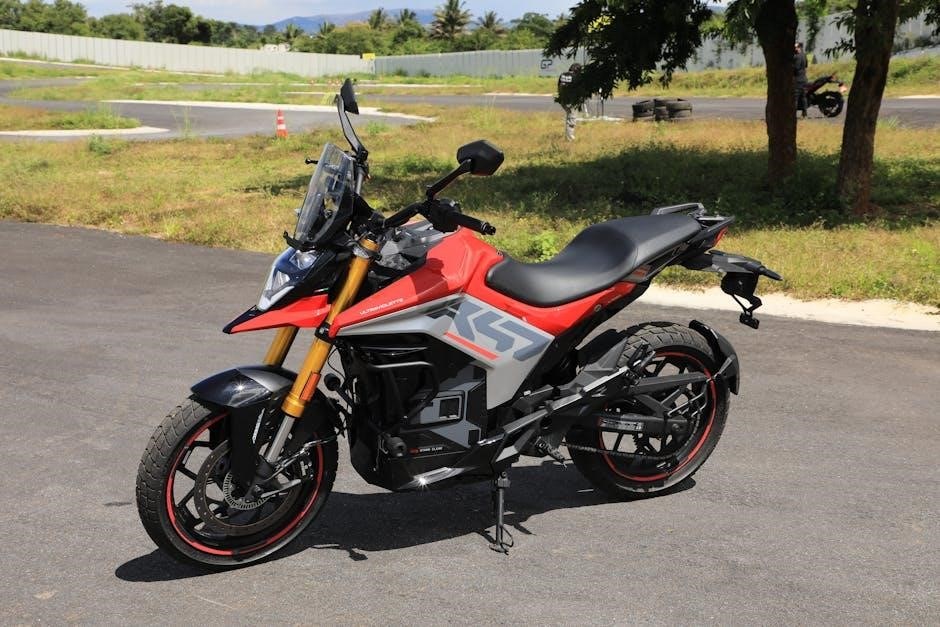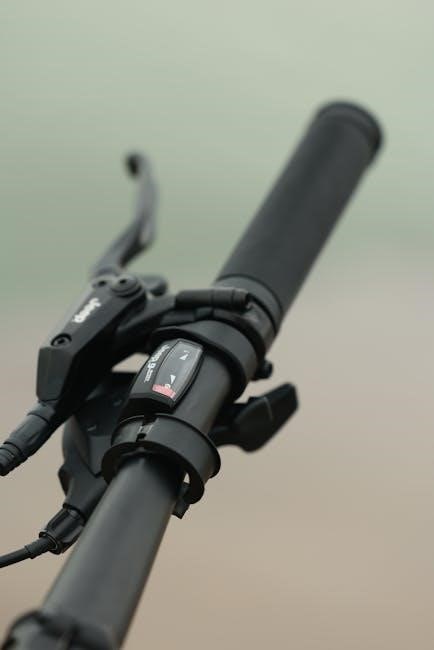Saris bike carriers are renowned for their innovative designs, offering secure, convenient, and compatible solutions for cyclists. With models like the Edge, Freedom, and SuperClamp, Saris continues to redefine bike transport, catering to diverse vehicle types and riding needs, ensuring safe and efficient bike transportation for enthusiasts everywhere.
1.1 Overview of Saris and Their Bike Carriers
Saris is a leading brand in bike transportation solutions, offering a wide range of innovative carriers designed for cyclists. Known for their durability and versatility, Saris bike carriers cater to various vehicle types, including hitch, roof, trunk, and spare tire setups. Their product lineup features models like the Edge, Freedom, and SuperClamp, each tailored to meet specific cycling needs. The Edge, for instance, is a hitch rack built for heavy-duty use, while the Tailgate Pad offers a practical solution for truck owners. Saris focuses on enhancing security, convenience, and compatibility, ensuring cyclists can transport their bikes safely and efficiently, regardless of the adventure.
1.2 Importance of Proper Bike Carrier Instructions
Proper bike carrier instructions are essential for ensuring safe, secure, and efficient bike transportation. Following the guidelines helps prevent damage to your bike, vehicle, and carrier, while also reducing the risk of accidents. Clear instructions enable cyclists to correctly install and use Saris carriers, such as the Edge or Freedom models, ensuring compatibility and optimal performance. By adhering to the steps, users can avoid common issues like loose connections or improper loading, which might lead to bike movement during transit. Proper instructions also simplify the process, saving time and effort. This ensures a hassle-free experience, allowing cyclists to focus on their adventures with confidence.

Types of Saris Bike Carriers
Saris offers a range of bike carriers, including the Freedom, SuperClamp, Edge, and Tailgate Pad, each designed for different vehicle types and cycling preferences, ensuring versatility and convenience.
2.1 Freedom Bike Carrier
The Saris Freedom Bike Carrier is a versatile and user-friendly option designed for cyclists seeking convenience and reliability. It is compatible with a wide range of vehicles, including those with standard hitch receivers, making it a popular choice for road trips and daily commutes. The Freedom carrier is known for its ease of installation and secure bike-loading mechanism, ensuring your bike remains stable during transit. It accommodates both road bikes and e-bikes, offering flexibility for different cycling preferences. With its durable construction and intuitive design, the Freedom Bike Carrier is an excellent choice for cyclists who value simplicity and efficiency in transporting their bikes.
2;2 SuperClamp Bike Carrier
The Saris SuperClamp Bike Carrier is a high-performance option designed for cyclists who prioritize security and ease of use. It features a robust clamping mechanism that ensures bikes are held firmly in place, minimizing movement during transit. The SuperClamp is compatible with a variety of bike frames and sizes, making it a versatile choice for both road bikes and e-bikes. Its sleek design and durable construction provide long-lasting reliability, while its user-friendly interface simplifies the loading and unloading process. The SuperClamp is an excellent choice for cyclists seeking a balance of strength, convenience, and compatibility, ensuring their bikes arrive at the destination in pristine condition.
2.3 Edge Bike Carrier
The Saris Edge Bike Carrier is the latest innovation in bike transportation, designed to offer enhanced security, convenience, and compatibility for cyclists. With a capacity of up to 190 pounds, it is ideal for eMTB users and fits 2-inch hitch receivers, ensuring stability and compatibility with a wide range of vehicles. The Edge features a sleek and durable design, providing a secure hold for bikes during transit. Its user-friendly interface and robust construction make it a reliable choice for cyclists seeking a high-performance bike carrier. Whether for road bikes or heavier e-bikes, the Edge delivers exceptional functionality, ensuring bikes are transported safely and efficiently to their destination.
2.4 Saris Tailgate Pad
The Saris Tailgate Pad is a versatile and durable accessory designed for secure bike transport on trucks and other vehicles. Available in 5- and 6-bike options, it replaces traditional straps with G-hooks, offering quicker and more versatile loading and installation. The pad is well-padded to protect bikes from scratches and abrasions, ensuring a safe and secure fit. Its robust design accommodates various bike sizes, including mountain bikes and e-bikes, making it ideal for cyclists who need a reliable solution for transporting multiple bikes. With its ease of use and enhanced protection, the Saris Tailgate Pad is a practical choice for cyclists seeking convenience and durability in bike transportation.
Pre-Installation Steps
Ensure vehicle compatibility, verify bike specifications, and gather all necessary tools and accessories before proceeding with the installation process for a smooth and efficient setup experience.
3.1 Choosing the Right Saris Carrier for Your Vehicle
Selecting the appropriate Saris carrier involves assessing your vehicle type, bike weight, and transportation needs. The Edge, Freedom, and SuperClamp models cater to different vehicles, such as SUVs, sedans, and trucks with hitch receivers; Consider factors like load capacity, compatibility with bike frames, and ease of installation. For instance, the Edge is ideal for eMTB users with 2-inch hitch receivers, while the Tailgate Pad offers versatile options for trucks. Ensure the chosen carrier aligns with your vehicle’s specifications to guarantee a secure and efficient bike transport experience. Proper selection prevents potential issues and enhances safety on the road.
3.2 Understanding Compatibility with Your Bike

Ensuring your bike is compatible with the Saris carrier is crucial for safe and secure transportation. Consider your bike’s frame size, tire width, and weight, as these factors influence carrier selection. The Edge model, for example, is designed for eMTB users and supports up to 190 pounds, making it ideal for heavier bikes. Additionally, verify that the carrier accommodates your bike’s wheel size and frame type, whether it’s a road bike, mountain bike, or e-bike. Some Saris carriers, like the Tailgate Pad, feature G-hooks for versatile loading, while others may require specific adjustments. Always check the carrier’s specifications against your bike’s dimensions to ensure a perfect fit and prevent potential issues during transport.
3.3 Gathering Necessary Tools and Accessories

Gathering the right tools and accessories is essential for a smooth installation and secure transport of your bike. Ensure you have an Allen wrench, screwdriver, and torque wrench for tightening connections. For Saris carriers like the Edge or SuperClamp, check if additional hardware is required. Accessories such as bike straps, G-hooks for the Tailgate Pad, and adapter bars for bikes without a top tube may be needed. Always refer to the specific carrier model’s requirements. Keep touch-up paint on hand for minor scratches and ensure your vehicle’s hitch or roof rack is compatible with the carrier. Having all items ready beforehand ensures a hassle-free setup and safe transportation of your bike. Proper preparation is key to avoiding delays or complications during installation.

Installation Instructions
Install Saris carriers by following model-specific guides for roof, hitch, or trunk mounting. Ensure proper assembly, secure attachment, and bike placement for safe transport.
4.1 Installing the Saris Roof Bike Carrier
Begin by following the manufacturer’s guidelines for your specific Saris roof bike carrier model. Ensure the roof rack is compatible and properly installed on your vehicle. Clean the roof surface to prevent dirt interference. Position the carrier on the roof rack, aligning it securely. Attach the carrier using the provided clamps or mounting hardware, ensuring a snug fit. Tighten all bolts and screws according to the torque specifications. Route the straps or cables correctly, avoiding any sharp bends. Double-check the stability of the carrier by gently rocking it. Finally, test the carrier by loading a bike temporarily to ensure it holds firmly. Always refer to the instruction manual for model-specific details.

4.2 Setting Up the Saris Hitch Bike Carrier
Start by attaching the Saris hitch bike carrier to your vehicle’s hitch receiver, ensuring it fits the correct hitch class (1.25” or 2”). Secure it with the provided pin or bolt, tightening firmly. Level the carrier to maintain stability and prevent bike movement. If your carrier has a tilt function, test it to ensure proper clearance with your vehicle’s trunk or rear door. Adjust the arms and cradles to accommodate your bike’s frame size and style. Attach the bikes, securing them with straps or locks. Double-check all connections and ensure the carrier is stable before driving. Refer to the manual for specific hitch compatibility and torque specifications.
4.3 Mounting the Saris Trunk Bike Carrier
Begin by cleaning the trunk area to ensure a proper fit. Attach the Saris trunk bike carrier by securing the straps to the trunk lid and hooks to the lip. Tighten all straps evenly to maintain balance and prevent shifting. Position the carrier centrally for optimal weight distribution. Adjust the arms to accommodate your bike’s frame size and style. Secure the bikes using the provided straps or locks, ensuring they are tightly fastened. Double-check all connections and straps for tightness before driving. Refer to the manual for specific torque and strap-tightening guidelines to ensure a secure and stable setup for safe transport.
4.4 Attaching the Saris Spare Tire Bike Carrier
Begin by loosening the spare tire to access the mounting surface. Attach the Saris spare tire bike carrier by aligning its base with the tire. Secure it using the provided bolts, ensuring a snug fit without over-tightening. Tighten the bolts evenly in a star pattern to maintain even pressure. Position the carrier arms to cradle the bike frame, adjusting for proper fit. Use the straps or hooks to secure the bike to the carrier, ensuring stability. Double-check the bolts and straps for tightness. Test the setup by gently rocking the bike to ensure it’s firmly attached. Always refer to the manufacturer’s torque specifications for the bolts to avoid damage to the spare tire or carrier.
Loading Your Bike onto the Saris Carrier
Loading your bike onto the Saris carrier is straightforward. Position the bike over the carrier, aligning the frame with the cradles. Secure the wheels and frame using straps or hooks, ensuring a snug fit. Adjust the carrier arms to accommodate the bike’s size and shape for optimal stability. Double-check all straps and connections to ensure safety and prevent movement during transport. Always follow the manufacturer’s guidelines for weight limits and proper loading techniques to avoid damage or instability.
5.1 Securing the Bike to the Carrier
Securing your bike to the Saris carrier is essential for safe transport. Begin by positioning the bike on the carrier, ensuring the frame is centered and balanced. Use the provided straps or hooks to fasten the bike firmly to the carrier. Tighten the straps evenly to avoid applying too much pressure on one part of the bike. For added stability, ensure the wheels are secured with additional straps or ties. Check that the handlebars are tightly fastened to prevent movement. Double-check all connections to confirm they are snug and will not loosen during travel. Always refer to the Saris instructions for specific securing methods tailored to your carrier model.
5.2 Adjusting the Carrier for Bike Fit
Adjusting the Saris carrier to fit your bike is crucial for a secure and stable transport experience. Begin by positioning the bike on the carrier and ensuring it is centered. Use the adjustable arms or brackets to accommodate the bike’s frame size and shape. For bikes with unique geometries, such as mountain or road bikes, fine-tune the carrier’s settings to prevent damage or movement. Tighten the quick-release straps or knobs to hold the bike firmly in place. If your carrier has wheel hoops, adjust them to match the bike’s wheelbase. Double-check the fit by gently rocking the bike to ensure it is stable and evenly balanced on the carrier.
5.3 Loading Multiple Bikes Safely
Loading multiple bikes on a Saris carrier requires careful planning to ensure safety and stability. Always follow the carrier’s capacity guidelines to avoid overloading. Start by securing the heaviest bike first, placing it closest to the vehicle. Position subsequent bikes evenly, leaving enough space to prevent contact and potential damage. Use the carrier’s adjustable features to accommodate different bike sizes and frame styles. Ensure each bike is tightly secured with straps or locks, and double-check that all connections are stable. If using a carrier with a tilt feature, test it with all bikes loaded to ensure smooth operation. Always verify that the total weight does not exceed the recommended limit for safe transport.

Post-Installation Checks
Post-installation checks ensure your Saris carrier is secure and properly aligned. Verify all connections are tight, straps are snug, and the carrier is stable. Inspect for any wear or misalignment to guarantee safe transport.
6.1 Ensuring Proper Carrier Alignment
Proper alignment of your Saris bike carrier is crucial for safe and stable transport. After installation, check that the carrier is evenly positioned on your vehicle. Ensure it is parallel to the ground and centered to avoid uneven weight distribution. Use the manufacturer’s alignment guide or measure from the vehicle’s edges to confirm accuracy. If using a roof carrier, verify that it is aligned with the crossbars. For hitch or trunk mounts, check that the carrier is securely locked and evenly spaced. Misalignment can lead to instability, so double-check the carrier’s position before loading bikes. Proper alignment ensures optimal performance and prevents potential damage to your vehicle or bikes.
6;2 Tightening All Connections and Straps
Tightening all connections and straps is essential for ensuring a secure and stable setup. Begin by using the provided tools to snug all bolts and fasteners in the carrier. Next, inspect all straps, hooks, and brackets to ensure they are properly engaged and tightened evenly. Over-tightening should be avoided to prevent damage to the carrier or vehicle. Double-check the hitch, roof, or trunk connections to confirm they are firmly locked in place. Loose connections can lead to instability during transit, potentially causing damage to your bike or vehicle; Always refer to the manufacturer’s torque specifications for precise tightening instructions. Properly secured connections ensure a safe and worry-free transportation experience.
6.3 Testing the Carrier Stability
Testing the carrier stability is a critical step to ensure safe bike transport. Begin by gently rocking the loaded bikes back and forth to check for any movement or wobbling. Verify that the carrier remains firmly attached to your vehicle and does not shift under pressure. If the carrier feels unstable, tighten any loose connections or straps. Perform a short test drive at low speeds to observe how the carrier performs while moving. Stability is key to preventing damage to your bike or vehicle during transit. Always ensure the carrier is evenly balanced and securely fastened before embarking on your journey. Stability testing ensures a smooth and safe ride for both your bike and vehicle.

Safety Precautions While Driving

Always check bike security before driving, maintain safe speed limits, and avoid sharp turns to ensure stability and safety with a loaded Saris carrier.
7.1 Checking Bike Security Before Driving
Before driving, always inspect the Saris bike carrier to ensure your bike is securely fastened. Check the straps, buckles, and clamps for tightness and proper alignment. Verify that the bike is locked to the carrier and the vehicle to prevent theft. Ensure the carrier is stable and evenly loaded to maintain balance while driving. Double-check that all safety pins, hitch tighteners, or roof rack attachments are securely in place. Look for any loose parts or signs of wear that could compromise safety. Perform a quick walk-around to confirm everything is in order. This careful pre-drive routine helps prevent accidents and ensures a smooth journey with your bike safely in tow.
7.2 Maintaining Safe Speed Limits
Maintaining safe speed limits is crucial when transporting bikes using a Saris carrier. Reduce your speed to avoid putting extra strain on the carrier and ensure stability. Sudden acceleration or sharp turns can destabilize the bikes, so drive smoothly and cautiously. Always adhere to posted speed limits, especially on highways or winding roads. Avoid exceeding speeds that could compromise the carrier’s grip or balance. Be mindful of road conditions, such as rain or wind, which may require further reducing speed. By driving responsibly, you protect your bike, your vehicle, and other road users, ensuring a safe and efficient transport experience.
7.3 Avoiding Sharp Turns with a Loaded Carrier
Sharp turns with a loaded Saris bike carrier can destabilize the bikes and increase the risk of damage or loss. To ensure safe transport, avoid making sudden or sharp turns, especially at high speeds. Instead, slow down gradually before turning and use wider, sweeping turns whenever possible. Signal your intentions early to alert other drivers and maintain a safe distance from other vehicles. Be particularly cautious on inclines or uneven roads, as these can amplify the risk of instability. By avoiding sharp turns, you protect your bike, the carrier, and your vehicle from potential damage, ensuring a secure and smooth transportation experience for all.
Maintenance and Upkeep

Regular maintenance ensures your Saris bike carrier remains reliable and functional. Clean the carrier after each use, paying attention to moving parts. Lubricate hinges and locks periodically.
8.1 Regular Cleaning of the Carrier
Regular cleaning is essential to maintain the functionality and longevity of your Saris bike carrier. Use a soft cloth and mild soap to wipe down the carrier, removing dirt, grime, and road debris. Avoid using harsh chemicals or abrasive materials that could damage the finish. Pay special attention to moving parts, such as hinges and clamps, to ensure they operate smoothly. After cleaning, dry the carrier thoroughly with a clean towel to prevent water spots and rust. For tough stains or grease buildup, a gentle degreaser can be used, but always rinse and dry afterward. Cleaning after each use helps prevent corrosion and keeps your carrier in optimal condition.
8.2 Lubricating Moving Parts
Lubricating the moving parts of your Saris bike carrier is crucial for smooth operation and long-term durability. Use a high-quality silicone-based lubricant or grease on hinges, pivots, and clamp mechanisms. Apply a small amount to each moving component, ensuring coverage without over-lubrication. Avoid using oil-based products, as they can attract dirt and dust. After lubricating, wipe off any excess with a clean cloth to prevent drips or mess. This maintenance step should be done every 1-2 months or after exposure to water, mud, or heavy use. Proper lubrication prevents rust, reduces friction, and ensures your carrier functions effortlessly when loading or unloading bikes.
8.3 Inspecting for Wear and Tear
Regularly inspecting your Saris bike carrier for wear and tear is essential to ensure its reliability and longevity. Check the straps, hinges, and clamps for signs of fraying, cracks, or corrosion. Look for any loose bolts or brackets and tighten them immediately. Inspect the paint or coating for chips or fading, as exposed metal can rust over time. Pay attention to the carrier’s frame and mounting points for dents or bends. If any damage is found, address it promptly by cleaning or replacing the affected parts. This routine check helps prevent breakdowns and ensures your bike remains secure during transport. Always clean the carrier after use to remove dirt and debris that may hide potential issues.
Troubleshooting Common Issues
Address loose connections, damaged paint, or loading difficulties. Inspect for wear, tighten bolts, and replace worn parts. Ensure proper alignment and secure bikes to prevent shifting during transit.
9.1 Addressing Loose Connections
Loose connections can compromise the safety of your bike during transport. Stop driving immediately if you notice any parts coming loose. Inspect all bolts, straps, and clips for tightness. Use the appropriate tools, such as an Allen wrench or screwdriver, to secure the connections. Regularly check the carrier before and after use to ensure stability. If a connection persists in coming loose, consider using threadlocker or consulting a professional for assistance. Properly securing all parts ensures safe and reliable bike transport, preventing potential damage or accidents on the road.
9.2 Fixing Scratches or Damaged Paint
Scratches or damaged paint on your Saris bike carrier can lead to rust or aesthetic issues. For minor scratches, clean the area with a mild detergent and water. Lightly sand the damaged spot to smooth the surface. Apply a rust-inhibiting primer and finish with a coat of paint that matches the carrier’s original color. For deeper scratches, repeat the process, ensuring complete coverage. Avoid using harsh chemicals, as they may damage the finish. Regular inspections can help identify and address issues early, maintaining the carrier’s appearance and durability. Always follow manufacturer guidelines for paint and care products to ensure optimal results.
9.3 Solving Bike Loading Difficulties
To address bike loading difficulties on your Saris carrier, start by ensuring the carrier is properly aligned with your vehicle’s hitch or roof rack, as misalignment can hinder loading. Check if your bike’s size and type are compatible with the carrier, especially if you have wider tires or a unique frame design. Adjust the straps and clamps to ensure they are secure and appropriate for your bike’s frame. Position the bike evenly on the carrier for balanced weight distribution. Consult Saris’s guidelines for specific loading techniques tailored to your bike type. Regularly clean and lubricate the carrier’s moving parts to maintain smooth operation. Finally, experiment with different loading angles to find the most efficient method for your setup.
Using Saris bike carriers ensures safe, efficient, and convenient bike transport. Proper installation, loading, and maintenance are key to maximizing durability and performance. Always follow instructions carefully for optimal results and enjoyable cycling adventures.
10.1 Summary of Key Instructions
Adhering to Saris bike carrier instructions ensures safe and efficient bike transport. Always verify vehicle and bike compatibility before installation. Secure bikes firmly using straps and brackets, and tighten all connections properly. Regular maintenance, such as cleaning and lubricating moving parts, extends the carrier’s lifespan. Perform pre-drive checks to confirm bike stability and carrier alignment. Drive cautiously, avoiding sharp turns, and keep speeds moderate. Store the carrier correctly when not in use to prevent damage. Following these guidelines ensures reliable performance and protects both your bike and vehicle during transport. Consistent adherence to instructions guarantees a hassle-free cycling experience.
10.2 Final Tips for Safe and Efficient Bike Transport
For safe and efficient bike transport, plan your route to avoid rough roads and construction. Ensure your bike is centered on the carrier to maintain balance. Always double-check local laws regarding bike transportation accessories. Secure loose bike parts, such as pedals or accessories, to prevent damage during transit. Use additional safety gear like reflective tape or lights for visibility. Upon arrival, inspect your carrier and bike for any signs of wear. Store your carrier properly when not in use to protect it from the elements. By following these tips, you’ll ensure a secure, damage-free, and stress-free cycling adventure every time.